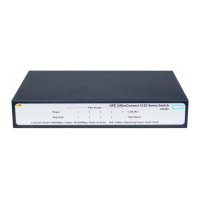219
command
Use command to assign a command to a job.
Use undo command to revoke a command.
Syntax
command id command
undo command id
Default
No command is assigned to a job.
Views
Job view
Predefined user roles
network-admin
Parameters
id: Specifies an ID for the command, in the range of 0 to 4294967295. A command ID uniquely
identifies a command in a job. Commands in a job are executed in ascending order of their command
IDs.
command: Specifies the command to be assigned to the job.
Usage guidelines
To assign a command (command A) to a job, you must first assign the job the command or
commands for entering the view of command A.
If you specify the ID of an existing command for another command, the existing command is
replaced.
Make sure all commands in a schedule are compliant to the command syntax. The system does not
examine the syntax when you assign a command to a job.
If a command requires a yes or no answer, the system always assumes that a Y or Yes is entered. If
a command requires a character string input, the system assumes that either the default character
string (if any) or a null string is entered.
A job cannot contain the telnet, ftp, ssh2, or monitor process command.
Examples
# Assign commands to the backupconfig job to back up the startup.cfg file to the TFTP server at
192.168.100.11.
<Sysname> system-view
[Sysname] scheduler job backupconfig
[Sysname-job-backupconfig] command 2 tftp 192.168.100.11 put flash:/startup.cfg
backup.cfg
# Assign commands to the shutdownGE job to shut down Ten-GigabitEthernet 1/0/1.
<Sysname> system-view
[Sysname] scheduler job shutdownGE
[Sysname-job-shutdownGE] command 1 system-view
[Sysname-job-shutdownGE] command 2 interface ten-gigabitethernet 1/0/1
[Sysname-job-shutdownGE] command 3 shutdown

